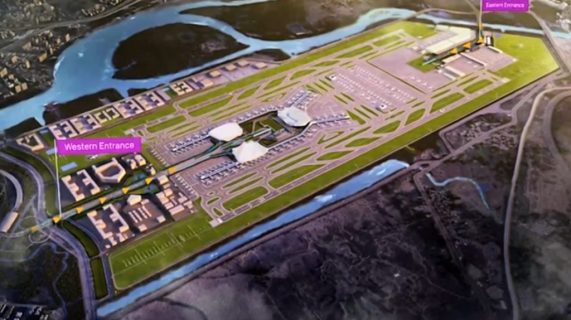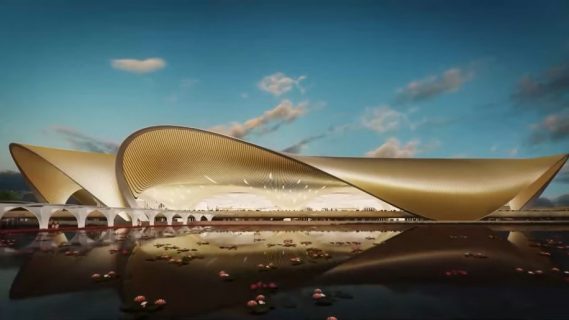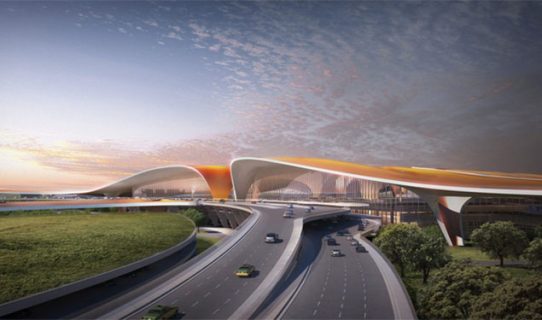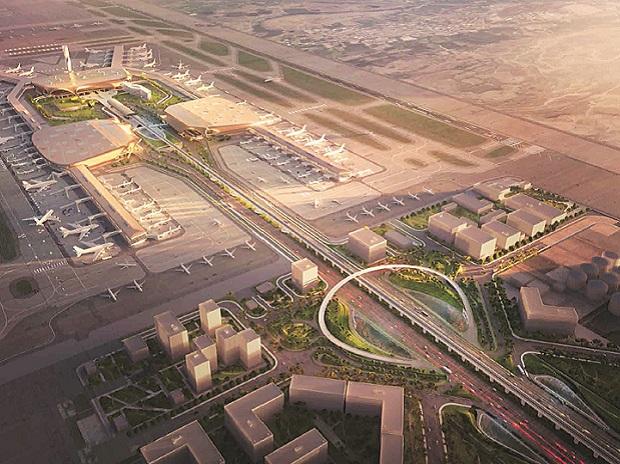Navi Mumbai International Airport project is a greenfield international airport that is being developed in Navi Mumbai. Maharashtra, India. To be precise the airport is coming up along the National Highway (NH) 4B near Panvel/Uran.
The airport is developed under a public-private partnership (PPP). The PPP is between the Airports Authority of India (AAI) and the Government of Maharashtra, together with Mumbai International Airports Ltd (MIAL).
The implementation of the Navi Mumbai International Airport project, the cost of which is US$ 2.5bn plus, began in August 2021. It is being executed in phases and it is expected to be completed concurrently starting from December 2024.
Scope of the Navi Mumbai International Airport project
The project entails the construction of an H-shaped five-level terminal building on a total area of 523,000m². The terminal comprises two concourses, 78 contact airport positions, 29 remote aircraft positions, and more than 350 check-in counters.
Also Read: Bugesera International Airport (BIA) project and all you need to know
It will also have three curbs, one at grade and two elevated. The first level curb will be meant for commercial vehicles, while the second and third respectively will be dedicated for arrivals and departures. In addition, the terminal will have a provision for online check-in and an integrated baggage handling system on an area of 13,290m².
The terminal building, upon completion, is expected to support a total capacity of 60 million passengers per year.

The project, in addition to the terminal building, also includes the construction of two parallel runways each 3,700 m long, 60 m wide, and 1.55km apart. Domestic and international cargo terminals will also be built on over 33,000 m2 and 23,700 m2 pieces of land respectively. Additionally, the project comprises the construction of a 151,000 m2 fuel farm, three aircraft hangars taxiways, an apron area, an aircraft maintenance site, and long-term aircraft parking.
Other infrastructure facilities set for construction include car parking, a power supply system and a water treatment plant. Two main access roads, i.e. Amra Marg in the west and NH 4B in the east, will provide connectivity to the Navi Mumbai International Airport.
Project Timeline
The Navi Mumbai International Airport project was first conceived back in November 1997. Between then and 2000, the idea to develop a single runway in the previous plan was dropped for a twin runway.
The Navi Mumbai site was selected and the City and Industrial Development Corporation of Maharashtra Ltd (CIDCO) was appointed to carry out a detailed Techno-Economic Feasibility Study (TEFS) of the project.
The TEFS was submitted to the State Government later in 2000 (September).
2007
CIDCO submitted a Project Feasibility and Business Plan Report to the MoCA in February. The project received in-principle approval from the Union Cabinet in July of the same year.

2008
In July, the Government of Maharashtra approved the development of the Navi Mumbai International Airport project on a PPP basis and selected CIDCO as the nodal agency for its implementation.
2014
CIDCO, in February, invited global tenders for requests for qualification (RFQ).
2017
GVK Group‘s Mumbai International Airport Ltd (MIAL) was announced in February as the winning bidder.
2018
Prime Minister Narendra Modi, in February, unveiled the foundation plaque at the groundbreaking ceremony for the project in Mumbai.
In March of the same year, Navi Mumbai International Airport (P) Limited (NMIAL), the special vehicle company formed for the implementation of the project appointed Zaha Hadid Architects (ZHA) to design the Navi Mumbai International Airport’s Terminal 1 and ATC Tower, and in August CIDCO floated a tender to select the engineering, procurement, and construction contractor for the project.
2019
In August, Larsen & Toubro was awarded a contract for Phase 1 construction of the Navi Mumbai International Airport.

2021
On 11 June, the proposed design of Navi Mumbai International Airport was revealed. The design features three interconnected multi-level passenger terminals with a lotus-inspired shape. Later the same month Maharashtra State Cabinet approved Adani Airport Holdings’ (AAH) concession agreement regarding Navi Mumbai International Airport.
July 2021
Adani Airports, which now has a controlling interest in MIAL after acquiring 74% of assets in the latter, announced plans to commence works to develop Navi Mumbai International Airport in Aug-2021, and expectations to complete financial closure for the airport development project within the next 90 days.
September 2021
Ajit Pawar, Maharashtra’s Deputy Chief Minister said that the state government anticipates works to develop Navi Mumbai International Airport to be completed and the airport commissioned in 2024.
October 2021
The Union Environment Ministry formed an expert appraisal committee (EAC) that recommended a fresh environmental clearance (EC) granted to the Navi Mumbai International Airport (NMIA). The decision was made during the last EAC meeting. The terms and conditions for the project’s nodal agency granted in 2010 by EC were retained. The modern greenfield NMIA is set to become the second major airport in the Mumbai Metropolitan Region after the Chhatrapati Shivaji Maharaj International Airport was founded in Santacruz.
March 2022
Financial closure for Navi Mumbai International Airport project achieved
The Adani Group has achieved financial closure for the Navi Mumbai International Airport Project. This achievement signifies Adani Group’s commitment to mobilizing the required resources for the facility as well as completing the construction works within the scheduled timelines.
A subsidiary of Adani Enterprises Ltd (AEL), Navi Mumbai International Airport Private Ltd has achieved financial closure with the execution of financing documents with the SBI (State Bank of India). The entire debt requirement of Rs 12,770 was underwritten by the State Bank of India for the project.
The Navi Mumbai International Airport Project will be located in the booming city of Mumbai in India. It will be a greenfield international airport and will serve in parallel alongside the already existing Chhatrapati Shivaji Maharaj International Airport. The airport is also projected to be India’s very own and first urban multi-airport.
The first phase of the airport will be able to handle well over 10 million passengers in a year. It is also said that the first phase will, later on, be expanded to its final capacity of being able to handle an impressive 90 million passengers in a year. The airport’s air traffic control (ATC) tower, as well as the airport passenger terminal, will be designed by Zaha Hadid Architects, based in London. The final master plan for the project will be done by Jacobs Engineering Group, based in Texas.
The Director of the Navi Mumbai International Airport, Jeet Adani expressed that Adani Group is focused on not only creating but providing the best-in-class airport infrastructure as well as allied services to the consumer. He revealed that they aim to cover the country’s biggest cities with other surrounding towns and cities in a hub and spoke-like model.
Jul 2022
Navi Mumbai International Airport project 100% land acquisition done
Navi Mumbai International Airport project has achieved a major milestone. The City and Industrial Development Corporation (CIDCO) has reportedly acquired 100% of the land required for the development of the project. The Maharashtra government’s town planning authority evicted all 3,070 structures in the project area.
These structures included public and private buildings, churches as well as community temples, schools, and cemeteries. CIDCO also completed all necessary and important pre-development works in the airport area.
Also Read: Mumbai–Ahmedabad High-Speed Rail, India’s maiden high-speed rail project
Speaking on this milestone Sanjay Mukherjee, Vice Chairman, and Managing Director, CIDCO said, “CIDCO has successfully completed this important milestone due to the cooperation of the PAPs (project-affected persons) of Navi Mumbai International Airport. It was challenging clearing the airport site. However, we are great full that the project is on track and proceeding as per the scheduled timelines.”
The town planning body has since handed over the 2,866-acre piece of land to Adani Enterprises. The latter is the concessionaire for the development of the Navi Mumbai International Airport project.
Navi Mumbai International Airport PAPs rewarded for their contribution
Considering the contribution made by the PAPs from the 10 villages in the Panvel area of Raigad district near Mumbai where the project site sits, CIDCO has already availed a comprehensive rehabilitation package approved by the government of Maharashtra.
As part of this package, the Maharashtra government’s town planning authority will develop Pushpak Nagar. The latter will be a complete rehabilitation and resettlement area with the entire physical, social, and cultural infrastructure near the airport area.
The rehabilitation of more than 5,000 families from the evicted buildings to the rehabilitation and resettlement area is near completion according to CIDCO.
June 2023
Navi Mumbai International Airport to be completed in 2024
The Navi Mumbai Airport is set to be completed in 2024 to alleviate congestion at Mumbai’s existing airport while enhancing air travel and economic growth.
The airport, located in Ulwe, Navi Mumbai, will consist of two initial phases and cover an expansive 1,160-acre area. With a design inspired by the lotus, India’s national flower, the airport combines cultural heritage with modern technology to offer a seamless experience for passengers. A joint venture between the Adani Group and City and Industrial Development Corporation (CIDCO), the airport will have state-of-the-art facilities and can accommodate up to 90 million passengers by 2032.
Connectivity is a key focus of the Navi Mumbai Airport, with its location only 40 kilometres away from Mumbai’s existing airport and connected by the 22-kilometre Mumbai Trans-Harbour Link (MTHL), which provides road access. Furthermore, the airport emphasizes sustainability through eco-friendly initiatives such as energy-efficient systems, solar power generation, and the exclusive use of electric vehicles. These efforts align with the airport’s commitment to reducing its environmental impact.
Overall, the Navi Mumbai Airport aims to offer a modern and efficient travel experience, relieve congestion, and foster regional and international connectivity, while prioritizing sustainability through its design and operations.
Jun 2023
Civil works at Navi Mumbai International Airport project site in India 17.85% complete
The implementation of the civil works for Navi Mumbai International Airport in India is 17.85% complete. This is according to the City Industrial Development Corporation (CIDCO). The latter is an Indian city planning agency and the richest government authority in India. It was formed and is controlled by the Government of Maharashtra.
According to CIDCO, 50% of the total work has been completed with regard to rock-cutting as well as site-filling works. The filling work, especially on the south runway, is nearly complete while the laying of the granular sub-base is scheduled to start next week.
Additionally, hill-cutting for the terminal building footprint area has been completed, while 95% of the excavation for the basement/foundation is done. Furthermore, according to CIDCO, the first mega-column footing was cast on November 2.
Meanwhile, blasting and excavation work for the Multi-Level Car Park (MLCP), Central Utility Plant building and Navi Mumbai International Airport Limited project office is in good progress. The financial progress attained by the Navi Mumbai International Airport project stands at 18.27%.


*. Provision of Third Runway in
Future Expansion
*. connectivity with Metro and
Bullet train
*. Duration of checkin and
Boarding should not be more
than one Hour only
*. All roof should be designed
as Solar pannel To generate
Required Electricity
Thanks
Electricity Tha
* provision of Future expansion
for third Run way
* Connecting with Metro train
and Bullet train
* Duration of check inn and
Boarding should not be exceed
more than one Hour
* complete Roof should be
designed as Solar Pannel
Thanks